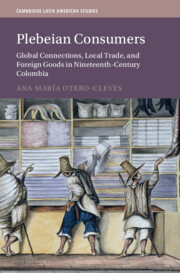 Plebeian Consumers
Plebeian Consumers Book contents
- Plebeian Consumers
- Cambridge Latin American Studies
- Plebeian Consumers
- Copyright page
- Dedication
- Contents
- Figures
- Acknowledgments
- Introduction
- 1 Consumers, Citizens, and the Republican Project
- 2 From Ferias to Tiendas
- 3 Zarazas, Bayetas, and Bogotanas
- 4 Machetes, Axes, and Foreign Tools
- 5 Books, Hats, and “Foreign” Coats
- 6 Soap, Pills, and Toiletries
- Epilogue
- Glossary
- Bibliography
- Index
- Series page
4 - Machetes, Axes, and Foreign Tools
Demanding Consumers, Active Citizens
Published online by Cambridge University Press: 18 December 2024
- Plebeian Consumers
- Cambridge Latin American Studies
- Plebeian Consumers
- Copyright page
- Dedication
- Contents
- Figures
- Acknowledgments
- Introduction
- 1 Consumers, Citizens, and the Republican Project
- 2 From Ferias to Tiendas
- 3 Zarazas, Bayetas, and Bogotanas
- 4 Machetes, Axes, and Foreign Tools
- 5 Books, Hats, and “Foreign” Coats
- 6 Soap, Pills, and Toiletries
- Epilogue
- Glossary
- Bibliography
- Index
- Series page
Summary
Chapter 4 studies the political, cultural, and economic impact of foreign machetes and other agricultural tools. It shows how popular men and women’s expert knowledge about these goods was not transferred from above or received from abroad but inherited and acquired in practice. Peasants and muleteers used machetes to clear the land, grow their crops, and travel the country; artisans, bogas, and smallholders, to defend their honor, their lives, and their property. As this chapter shows, over the course of the nineteenth century, foreign tools, especially the machete, reshaped these popular actors’ collective identities and underscored their contribution to the nation’s material improvement and progress – not only as part of the country’s labor force but as consumers themselves. Although these Plebeian consumers might have had limited choices due to their limited purchasing power, this did not preclude them from appropriating foreign tools, expressing dissatisfaction with certain agricultural implements, and seeking ways to access the ones they liked and preferred. Most important, machetes allowed them to shape and reiterate their citizenship on the ground. As such, Colombia’s popular consumers became not only critical agents in the global market but active and productive citizens of the new republic.
Keywords
- Type
- Chapter
- Information
- Plebeian ConsumersGlobal Connections, Local Trade, and Foreign Goods in Nineteenth-Century Colombia, pp. 118 - 150Publisher: Cambridge University PressPrint publication year: 2024
